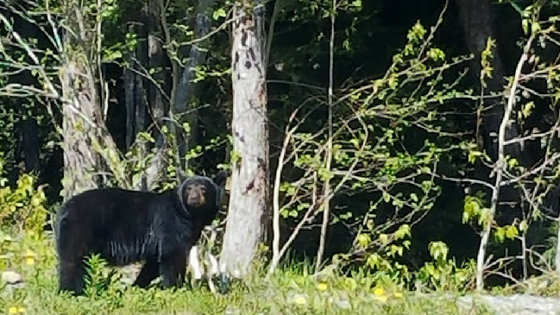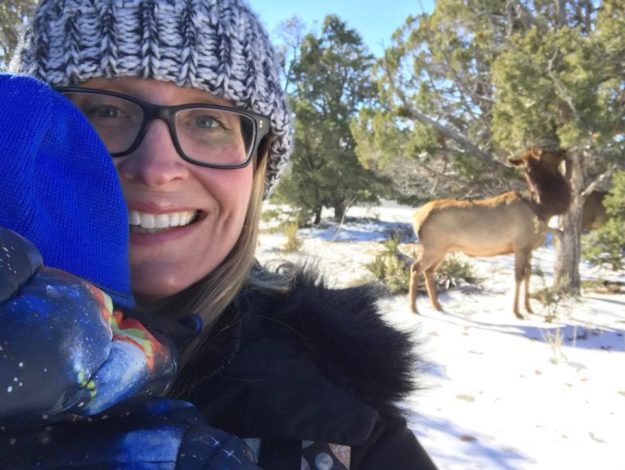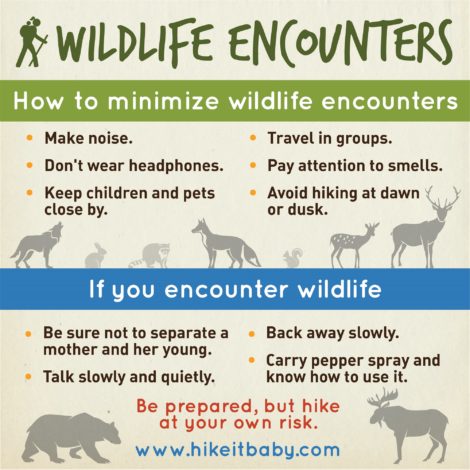How to be prepared for wildlife encounters on the trail
To many hikers, the idea of wildlife encounters on trail is something of an "urban" myth. But depending on where you live, it may be more than plausible and a matter of when, not if. The good news is that wildlife encounters aren't a reason to avoid the great outdoors. On the contrary, as with all things, being prepared is half the battle. Because while bears, mountain lions, and other wildlife do happen, there are quite a few things you can do to minimize encounters or reduce them entirely. 
Black bear near popular hiking trail. Photo courtesy Erin Pennings.
How to Minimize Wildlife Encounters
Make noise. The bottom line is that most wildlife wants to avoid you as much as you want to avoid them. So make plenty of noise so that you don't surprise them. This can be singing, talking, or even clanging hiking poles together.
Travel in groups. Part of this comes back to making noise. The more of you there are, the more noise you make inadvertently without trying. Bonus, loud children on trail make lots of noise. Different resources recommend different group sizes, but everyone agrees that hiking with a group is the best way to minimize wildlife encounters.
Don't wear headphones. If you wear headphones while on trail, not only are you less likely to make noise, but you'll miss hearing key noises that might clue you in to nearby wildlife.
Pay attention to smells. Some bears can have a very distinct smell that you can detect from far away. If something smells funky, be aware of your surroundings.
Keep children and pets close by. Don't allow them to run ahead and potentially surprise wildlife. Also consider that wildlife can come on to the trail between you and a child.
Avoid hiking at dawn or dusk. This is when many animals, including bears and mountain lions, are most active. 
Jordan Else with an elk in background. Photo courtesy of Jordan Else.
If You Encounter Wildlife
Be sure not to separate a mother and her young. Humans aren't the only creatures who are protective of their young. And the worst place to be is between a mother and her cubs or calves. So be watchful, and if you encounter wildlife, do your best to stay out of the middle.
Back away slowly. Make yourself seem like less of a threat and back away slowly. Don't turn your back or run, no matter what you do. And, definitely, don't approach the animal.
Talk slowly and quietly. This ties back into making yourself seem like less of a threat.
Carry pepper spray and know how to use it. Several brands offer a practice canister that you can use to get the hang of how the spray works. It's effective against bears and mountain lions, among other large animals. Keep in mind that it only works if you're extremely close to an animal, so it should be a last resort. And, remember not to spray into the wind. (Tip: If you absolutely must deploy the pepper spray, leave the area as soon as possible because after the intensity dissipates, curious animals may come to investigate.)
Be Prepared, but Hike at Your Own Risk
What else can you do to be prepared? If you live in bear country, wolf country, mountain lion country, moose country...anywhere that has large wildlife that can prove a threat to hikers, there are probably classes available to you. Check with the branch of the park service closest to you, whether local, state or federal, and you will find a variety of classes available to you. And while it goes without saying that every hike is at your own risk, keep in mind that wildlife attacks, though highly sensationalized, are rare. It's more dangerous to get in a car every day, yet we do that without thinking twice. So we encourage you to take appropriate precautions and have a great time making memories outdoors with your family. 
Read More:
ABOUT OUTGROWN
OutGrown is a 501(c)(3) nonprofit that works to create a world where everyone can enjoy the physical and mental benefits of spending time outside. We are focused on creating opportunities and removing barriers to access so families with babies and young children can take their first steps outside. We believe all families have the right to connect with nature, benefit from spending time outdoors and be inspired to a lifelong love of nature. Since its grassroots inception in 2013, OutGrown is a growing community of 280,000 families and over 300 volunteer Branch Ambassadors. More information on all of our programs can be found at WeAreOutGrown.org
EDITORS NOTE:
We hope you enjoyed reading this article from OutGrown. We’re working hard to provide our community with content and resources that inform, inspire, and entertain you.
But content is not free. It’s built on the hard work and dedication of writers, editors, and volunteers. We make an investment in developing premium content to make it easier for families with young children to connect with nature and each other. We do not ask this lightly, but if you can, please make a contribution and help us extend our reach.
Related Content




Comments